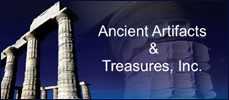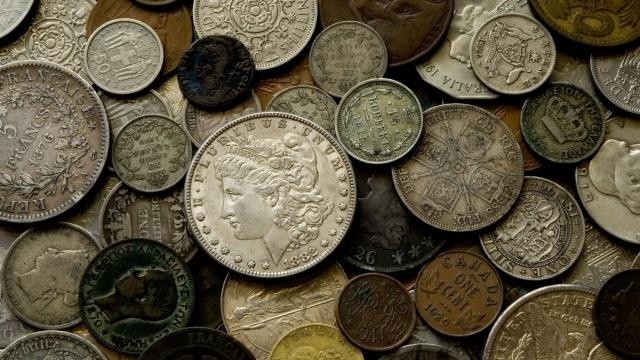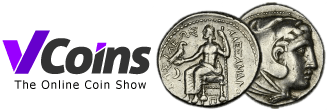Few things are more exciting than adding special pieces to a collection. Whether you collect artifacts, ancient coins, fossils, minerals, crystals or other antiquities from around the world, Ancient Artifacts & Treasures, Inc. has the inventory selection for you.
How To Sell Your Coin Collection by Gary Eggleston
So, you feel it’s time to sell your long-time Coin Collection, or you might have inherited a collection and you know nothing about coins and you would like to sell them. As with the sale of anything, you would like to make sure you get a fair price. Sounds simple enough, right? In the field of numismatics, when it comes time to sell, offerings for your collection will vary greatly. The following hints will help guide you to getting a reasonable and fair offer. I will talk more on the term “reasonable” a little bit later. Coin Dealers, like any other profession, number in the thousands. From part-time single person businesses to huge companies that buy and sell millions of dollars of coins yearly. And like other all other professions and industries, we have some crooks. By following the general tips in this article, you will be in a better position to realize your collections value. So here we go!
Most importantly, you need to recognize what you have. How come? If you don’t know what you have, how do you know you are getting a fair value for your coins? If you have thousands and thousands of wheat cents, I am not stating you need to inventory them all. As a matter of fact, it might not be worth your time. The probabilities of discovering a key coin are slim at best. But you had better know how many pennies you have. How? Simply weigh them. Wheat pennies come to approximately 148 pennies per pound. The same rule can apply to other common coins such as pre 1965 Roosevelt Dimes and Washington quarters as you will probably accept a bullion price for these coins. For the remainder of your collection, you might prefer to count the number of each piece. Be sure you have a complete list of your collection.
OK, time to contact a dealer? No, not yet. How do you know you are dealing with an honest one? Prior to contacting a dealer, you need to do some homework. Does the dealer belong to any organizations and/or clubs such as ANA (American Numismatic Association)? How long has s/he been in business? What is their reputation? Check out a few dealers before you make that call. Besides, just because they advertise in a major coin collecting publication, doesn’t make them honest. Most novice collectors wouldn’t know the difference.
Now that you have done some research, it’s time to contact the dealer. This can be done in several ways. You can give them a call or if you are the shy type, simply send them an email. In your email, identify yourself and that you have a collection for sale. Include in the email the inventory you completed. This might come as a shock to many, but some dealers WILL NOT want your collection. A lot of dealers specialize in certain types or series or could just have too many coins in their stock. If your collection is an average collection of common coins, you may be disappointed to find out that many, if not all of the big dealers simply don’t want to bother with you. It’s too time consuming for them to sort the common collections and the margins are simply too small for them to make a decent profit. Do not fret, all is not lost. A lot of smaller dealers will welcome the opportunity to get your collection. Many of these dealers work in mail-order exclusively and might have only an email or a PO Box as contact information. Although they might seem shady, these folks typically are quite respectable. As before, contact the dealer and inquire if they are interested. If they are not, just move on to the next dealer. If they are, ask them for their “buy price” list. Many dealers will publish a list of what they are willing to pay for certain coins.
After some laborious work, you should have a few offers on the table. The offers are probably not anywhere near what you anticipated. Recall what I said above about a “reasonable” offer? Here is the painful truth. Coin Dealers are in business to make money. Sure, many of us chose this profession because we enjoy it, but like everyone else, we still have mortgages, car payments, and college for kids, etc. Many people will search in the latest Coin Prices magazine or other price guide to come up with an idea of what their collection is worth. Magazines such as Coin Prices are actually a list of prices of what you can anticipate to pay a dealer for a particular coin, not what you can expect to get paid. Markups can range from 20-50% or more for smaller denomination coins such as wheat cents. As I mentioned earlier, some dealers just might not desire what you have. Besides, many, if not all dealers, reserve the right to revise the offer on inspection of the collection. If you believe all your Morgan Dollars are BU, but they are really AU, this will make a huge difference in price. Grading is extremely subjective. Also, for larger, more diverse collections, a dealer might spend a significant amount of time reviewing the collection to guarantee a fair price.
So, what to do? Accept the best offer and run? Maybe, maybe not. If this is an inheritance, and you have no emotional attachment, you can simply sell and never look back. If this is your collection of 50 years, well this perchance painful. You can proceed to contact different dealers and wait for a better offer. If you feel your collection is genuinely worth more, you can always consign it for auction. With some of the fees the major auction houses charge, it may not be worth it. You can likewise try your hand at eBay but unless you have a strong feedback profile, many buyers won’t bid on your items. Plus, eBay’s fees could cut into your profits considerably. You can also locate eBay members who will auction off your collection for you for a percentage of the take. Sometimes this works out well and sometimes not.
For now, let’s assume you have a fair offer, and you decide to sell. Incidentally, this should be a written offer sent via the mail or sent via email. Many times, the buyer may be in a different city or state. No buyer will send you a check until they’ve seen the collection. If the collection is large enough (many, many thousands of dollars), some buyers will come to you. If not, your most viable option is to ship the collection to the buyer via mail. Yes, that is right, via the mail. Wait you say that sounds risky.
It can be, but if you take precautions, you will have no problems. First, package the collection up very well. Be sure there are NO LOOSE coins jingling around. The sound of jingling coins is music to a thief’s ear. So be sure to wrap them up well and tight. When shipping via the mail, the USPS is reasonably safe. Normally, you will want to use USPS Priority Mail. Contact your local post office as you can ordinarily get free boxes. Generally, you will prefer to use the Flat Rate options as you can ship up to 70 pounds for under $10.00 (not including insurance) but ask your local postal clerk for options. For your protection, you MUST insure your package and pay for delivery confirmation. Include in your package an itemized list. Most dealers will appreciate this as they will audit the shipment to the list. If all is well, you can anticipate a check in the mail in no time.
In summary, here are the tips:
- Know what you have, prepare a comprehensive inventory
- Research some dealers before you contact one.
- Talk to dealers before sending coins to gage interest
- Send your coins. Package them well and insure them
- Review the offer
- Collect the cash!




Comments are closed.